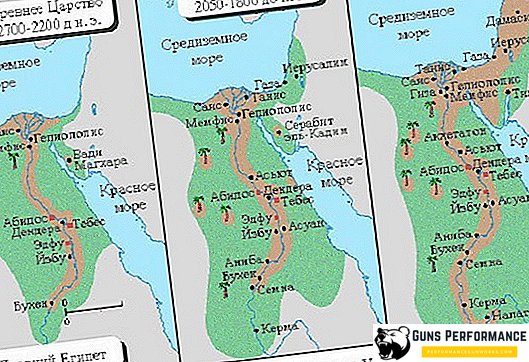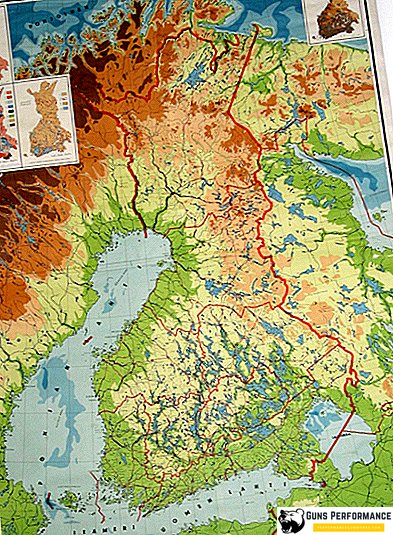Egypt holds a special place in the history of human civilization. It was here that one of the most powerful states of antiquity was formed, it was on these lands that the rich and distinctive culture of ancient Egypt arose. During the reign of the Pharaohs, the first forms of the state administration system were born, the role of the state in the development of social and civil relations was clearly indicated. But time is ruthlessly over the achievements of man. It spares neither the great and mighty rulers, nor their conquests; it destroys the achievements of entire nations and peoples. Beyond periods of power, there will inevitably be a period of decline. Egypt did not escape a similar fate, which eventually turned from a mighty empire into a provincial state.

That epoch when the power of the pharaoh was unshakable and unshakable was sunk into oblivion. First, the country in 332 BC the ancient Greeks, led by Alexander the Great, captured, and after three centuries Egypt generally became a Roman province, submitting to the evil genius of Julius Caesar. During this short period, the country has practically lost all its former heritage and culture that had been created on the banks of the Nile for centuries.
The goals and objectives pursued by the temporary governors of the province were completely at odds with the status of the cradle of human civilization. With this status, Egypt finally said goodbye. None of the subsequent caliphs or sultans, not one Ottoman Pasha or British consul managed to create a strong and durable state mechanism on the territory of the most ancient state. The country has always been on the outskirts of world politics, remaining a bargaining chip in the political bidding of more powerful and powerful states. During all this time, Egypt has experienced many tragic and dramatic moments. On this land, civil unrest and revolution constantly flared up, frequent revolts were accompanied by another invasion of more powerful neighbors. The country has long lived in the occupation mode, losing the last remnants of the historical legacy of the pharaohs.

Only in recent history, the place of Egypt becomes more or less defined. The country is struggling to get out of the sphere of influence of powerful political players. Attempts are being made repeatedly to find their own political path of development, to return the country to its former greatness. Much of this was possible only after the end of the Second World War, when the balance of forces on the political map of the world changed dramatically.

Recent history of the Egyptian state
The first outlines of the independence of Egypt began to emerge at the end of the XIX century. Despite the fact that the country was under the yoke of the Ottoman Empire, thanks to the efforts of Great Britain, Egypt walked along an independent path of development. At the turn of the century, the Turkish rulers could no longer control the centrifugal processes that were tearing the huge empire apart. In addition, the Europeans are constantly interfering in the affairs of the brilliant Porta, seeking to wrest from her crown the most tidbits. With the opening of the Suez Canal, Britain no longer let Egypt out of its sphere of influence.

The Anglo-Egyptian War of 1882 marked the beginning of the formal occupation of the country. Egypt was de jure ruled by the Ottoman Empire, but the British ruled the country. With the beginning of the First World War, the British actually turned the territory of Egypt into their protectorate, which was legally issued in November 1914. Having managed to keep such a large country in the sphere of its influence, Great Britain did not refuse to attempt to create their Egyptian Sultanate - a friendly British state. There was no question of any democratic forms of government. In those years, in the Arab country, only the monarchy could become the only effective form of government. The next step on the road to independence of the Egyptian state was the proclamation of the Kingdom of Egypt in 1922.

It cannot be said that the kings of Egypt have become significant figures in the new history of the state, but the royal power has managed to give a harmonious form to the state control system. Finally, a country emerged in the country, which could really control its own territory both economically and politically. Remaining de jure independent and sovereign state, under the kings of Egypt was in the sphere of British influence. With the help of the British, order was established in the financial sector of the economy, administrative and management reforms were defined. The first king of Egypt was Faud I - a descendant of the Egyptian Sultan Muhammad Ali. The royal power in the country existed until 1953, when the young and ambitious military staged an anti-war military coup.

Total on the throne during the existence of the kingdom was visited by three monarchs. Following Faud I, his son Farouk ascended to the throne, continuing the reigning dynasty of his grandfather Muhammad Ali. For sixteen years the country was ruled by King Farouk I. It was during this period that nationalism grew, which was manifested in dissatisfaction with the strong British influence that was felt in the country. The authority of the royal power was severely undermined by corruption, which covered all echelons of state power. Incompetence of power in domestic policy, the disastrous results of the first Arab-Israeli war of 1948 put an end to the Egyptian monarchy.

Difficult internal political situation led the country to the 1952 revolution. Under the pressure of the military, King Farouk I was forced to abdicate the throne in favor of his son Faud, who for a short period became king of Egypt. However, subsequent events led to the fall of the institution of monarchy. From this moment begins a new period in the history of the country - Republican Egypt.
Revolution, Arab Republic of Egypt and Presidential Power
After a new monarch entered the royal palace in Cairo, the situation in the country did not stabilize. The royal power in the face of the baby - King Faud II at that time was not more than a year - was formal. All national issues involved the revolutionary Movement of Young Officers, headed by Mohamed Nagib and Gamal Abdel Nasser.
An attempt to establish a civilian system of government in the country failed. The revolutionaries decided to completely change the state structure of the country. In 1953, the Constitution of the country, through which royal power was held, was abolished. From this moment Egypt ceases to be a kingdom and is declared a republic. In the state established the presidency of Egypt.

The first Republican president of the country is Mohamed Nagib, who previously headed the royal government. However, the tenure of the new head of state was limited to 484 days. The first president of Egypt in November 1954 was removed from his post. Power in the country passed into the hands of the Revolutionary Command Council, chaired by Colonel Gamal Abdel Nasser. From this period begins the period of the return of Egypt to the fold of world politics.
Unlike other countries of the third world, where presidents changed with the speed of film personnel, the presidential power in Egypt proved to be quite strong and stable. From 1956 to the present, the country had only six presidents. In chronological order, the list of heads of state is as follows:
- Gamal Abdel Nasser, years of board 1956-1970;
- Anwar Sadat took office in September 1970 and was in power until October 6, 1981;
- Hosni Mubarak was in the presidency for just over ten years - from 1981 to 2011;
- Muhammad Mursi was elected in June 2012 and remained in the highest public office until July 2013;
- Abdul-Fattah Al-Sisi became the Head of State in June 2014 and continues to hold a high position until today.

This list shows how long the Egyptian presidents held their posts. Unlike other countries with a republican form of government, the government system in Egypt had its own national coloring. The status of the president was formally equal to the royal title, so the Egyptian presidents were in power until physical health allows you to hold a high position or the political situation in the country does not change radically. In this aspect it will be interesting to pay attention to the powers of the head of state. All Egyptian presidents in one way or another sought to strengthen presidential power. Repeated amendments to the current constitution, suspension of the Basic Law gave the presidents of Egypt virtually unlimited powers.
The country had a system of state power, where all legislative and executive power was in the hands of the head of state. The status enjoyed by the Egyptian presidents, starting with Gamal Abdel Nasser and ending with Hosni Mubarak, speaks eloquently that the head of state had unlimited power. The main support of the ruling regime was the army, which was the favorite object of attention of all presidents. Presidential decrees and orders had the force of law. The head of state bore the burden of not only the guarantor of the country's sovereignty, but also was responsible for the domestic political and economic situation in the country. In the sphere of foreign policy, all the heads of state who were in power had unlimited powers, which affected the growth of Egypt’s political influence among Arab countries and in the world.

The residence of the current head of state is the former royal palace, located in one of the outskirts of Cairo.
The most prominent presidents of the Republic of Egypt
Gamal Abdel Nasser
The appearance of a young independent state on the African continent led to a change in the political balance of power in the Arab world. This was facilitated by foreign policy, which from the first days of the formation of the republic began to promote its presidents. The first serious tests fell to the lot of Gamal Abdel Nasser, who became president in 1954. Among his merits is the nationalization of the Suez Canal, carried out in 1956. Thanks to Nasser, Egypt persevered during collective aggression from Britain, France and Israel, while maintaining its independence.

The efforts of Nasser Egypt owes its status as the leading state of the Arab world. The ideology of pan-Arabism, promoted by the second president of the country, promoted the formation of the United Arab Republic in 1958, the most powerful state formation in the Arab world since the medieval Arab Caliphate.
During his tenure as president, Nasser managed to take a comfortable foreign policy position, maneuvering between the major political players of the time - the United States and the USSR. With the active support of the Soviet Union under Nasser, the country walked along the lines of socialist transformations. In Moscow, they made big bets on President Gamal Abdel Nasser, trying to make Egypt an outpost of the socialist camp in the Middle East.
Among the merits of Nasser, a radical modernization of the country, mass social reforms in the field of medicine and the education system. The main duties that Gamal Abdel Nasser performed with a high degree of ambition lay in the plane of the revival of the Egyptian army. It was the army that was considered the guarantor of Egypt’s sovereignty and was the only instrument that would allow the country to establish itself as the leader of the Arab world. Having no competitors in the political arena, Nasser was again elected to the presidency in 1965. Thus, the second president of the country became the first Egyptian politician who managed to remain the Head of State for two consecutive terms.

However, Nasser’s foreign ambitions ran into no less ambitious plans for the young Israeli state. During the reign of Nasser, another Arab-Israeli crisis emerged, ending with the defeat of the combined Syrian-Egyptian forces in the 1967 Six-Day War. Failures on the front led to Nacer trying to voluntarily resign, but under pressure from the civil society movement was forced to stay in office. The second president of Egypt died on September 28, 1970 from a heart attack.
Anwar Sadat

After the death of Nasser, the country was headed by Anwar Sadat, who served as vice president. Up to this point, he was actively involved in the political life of Egypt. In 1961 and in 1964, Anwar Sadat held the high post of President of the National Assembly of the United Arab Republic.
With the advent of power, Sadat began to change the course of the Egyptian state, taken during the reign of his predecessor. The period of Sadat’s presidency was marked by the curtailment of the ideas of building an Arab socialist state. Under the third president, the United State of Egypt and Syria ceases to exist. Nationalist sentiments are growing in the country, fueled by the claims of the military to the dominant role of Egypt in the region. Having accused the USSR of inadequate military-technical assistance during the Six-Day War with Israel, Sadat takes a course toward rapprochement with the United States.
Hoping for military assistance from overseas, Sadat’s political regime began a new war in the Middle East. The military actions that were supposed to end with the defeat of Israel became the war of the Doomsday of 1973. The outcome of the failed military adventure and the subsequent armed confrontation was the signing of a peace agreement with Israel. In 1978, in the American Camp David, mediated by American President Jimmy Carter, Egyptian President Anwar Sadat and Israeli Prime Minister Menachen Begin signed a peace agreement. Despite the fact that this step was highly appreciated by the world community, the peace treaty with Israel led to the isolation of Egypt in the Arab world, whose countries did not recognize the existence of Israel.

Sadat's domestic policy, unlike success on the diplomatic front, was not successful. In 1977, bread riots swept the country. The country was mired in foreign loans, and the country's economy could not withstand the rapidly growing military spending. Under these conditions, the signing of a peace agreement with the eternal enemy led the third president of Egypt to a tragic finale. In 1981, the third president of the Arab Republic of Egypt was assassinated by Islamic fundamentalists during a terrorist attack. The attempt took place on October 6 during a military parade commemorating the anniversary of the Doomsday War.
Hosni Mubarak
After the bloody murder of Anvar Sadat, the republic was led by Hosni Mubarak. Under the administration of the fourth president, the country was 10,743 days — more than ten years. Prior to his election, Hosni was the Vice-President of Egypt and was considered the right hand of the current Head of State.

The first years of Mubarak's rule were marked by a decisive fight against corruption. Many associates of the former president were deprived of their positions and positions in the political beau monde as well as their freedom. Among the Egyptian politicians of the highest rank, Hosni Mubarak did not have such authority as his predecessors had, but with incredible efforts he managed to firmly take his place as Head of State. By removing all political opponents and trying to pursue a balanced policy within the country and in the foreign arena, Hosni Mubarak managed to achieve a lot. In the course of three national referendums, in 1987, in 1993 and in 1999, the people of Egypt preferred it. Despite the fact that the vote was uncontested, the power of Mubarak remained strong and unshakable. The last referendum of 1999 extended the powers of the current president for another six years.
The state of emergency, which was introduced in the country in view of the threat from radical Islamist organizations, made it possible to establish a strict dictatorship in the country. During the long reign, Mubarak survived six attempts on his own persona, but they all ended successfully for the president, which brought Egypt into the new millennium.

In 2005, Hosni Mubarak received an absolute majority in the elections and became president again, but the opposition condemned the election results and questioned them. The last straw of civil society’s patience was the revolutionary events that swept Cairo in late 2010 - early 2011. The country, which was in a state of emergency, was on the verge of bankruptcy. Mass unemployment, declining living standards and the lack of civil liberties have become a litmus test of the ruling regime. Под давлением оппозиции и восставшего народа четвертый президент Республики Египет февраля 2011 года сложил с себя полномочия действующего Главы государства. Передачей власти Совету Вооруженных сил окончилась тридцатилетняя эпоха правления Хосни Мубарака.












